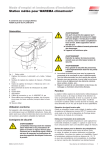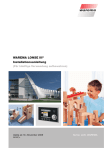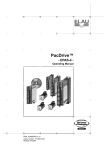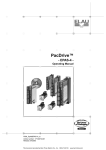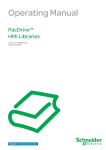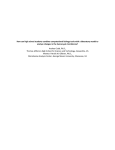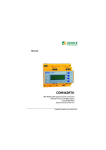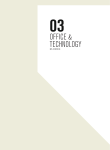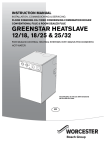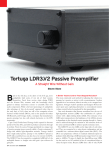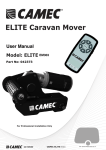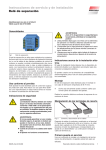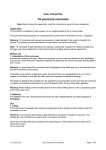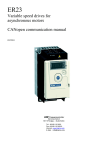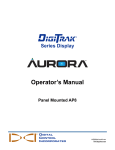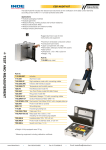Download User Manual Sensor Unit SE-BII
Transcript
Sensor Unit SE-BII User and installation Guide Art. - Nr. 816 503 Sensor Unit SE-BII No part of this guide may be reproduced by mechanical or electronic means without written permission of REKO electronic GmbH. All information and data in this guide is given to the best of out knowledge but without any warranty. We reserve the right to carry out improvements and corrections to the hardware, software and documentation at any time without previous notice. We welcome any suggestions or criticisms you may have. All the product designations used in this guide may be trademarks or registered trademarks of the corresponding holder. If you have any questions, please do not hesitate to contact your specialist supplier: Phone: IMPRINT Publisher: REKO electronic GmbH Dillberg 33 97828 Marktheidenfeld Germany www.reko-electronic.de 2 • We reserve the right to carry out improvements • 6680416a • 816503 • Fo • 16.02.2001 Sensor Unit SE-BII User and Installation Guide Sensor Unit SE-BII 6680416a • 816503 • Fo • 16.02.2001 • We reserve the right to carry out improvements • 3 Sensor Unit SE-BII 4 • We reserve the right to carry out improvements • 6680416a • 816503 • Fo • 16.02.2001 Sensor Unit SE-BII Table of contents Properties 7 1. On your safety 1.1 Explanation of pictograms and symbols 1.2 Proper use 1.3 Target group 1.4 Retrofitting and modifications 1.5 Mounting/Connection/Maintenance/Repairs 8 8 10 10 11 11 2. Mounting 2.1 2.3 2.2 2.4 2.5 2.6 2.7 2.8 13 14 16 16 16 17 17 17 18 Mounting Mounting Mounting Mounting Mounting Mounting Mounting Mounting the the the the the the the the device „Wind“ Type 3H sensor „Photo“ Type III sensor „Wind direction“ sensor temperature/humidity sensor „Precipitation“ sensor (infrared) „Outdoor temperature“ sensor „Radio clock“ sensor 3. Information on connecting 3.1 Information on connecting 3.2 Setting up the inputs „Photo 1” to „Photo 8” 19 19 20 4. Terminal diagrams 21 Technical data 30 Notes 31 Registered trademarks Echelon® , LON® , LONMARK® , LONWORKS® , LONBUILDER® , LONTALK® are trademarks of the Echelon Corporation, registered in the USA and in other countries. 6680416a • 816503 • Fo • 16.02.2001 • We reserve the right to carry out improvements • 5 Sensor Unit SE-BII 6 • We reserve the right to carry out improvements • 6680416a • 816503 • Fo • 16.02.2001 Sensor Unit SE-BII Properties The SE-B II sensor unit is a LONWORKS ® system component, manufactured in accordance with LONMARK® guidelines. The following meteorological sensors can be connected to the device: • • • • • • 1 „Wind direction“ sensor 1 „Relative humidity“ sensor 1 „Temperature“ sensor 8 „Photo“ sensors (inputs can be changed over from the voltage to the current interface) 3 „Wind speed“ sensors 1 „Precipitation“ sensor In addition, it is possible to connect a DCF77 radio clock module. A power supply for active sensors (12 V DC ) is integrated in the device. The sensor unit is included in a LONWORKS® network and makes the measured values of the connected sensors available on the LONWORKS® network in the form of network variables. The sensor unit calculates the position of the sun as a factor of the date and time as well as the geographic position of the sun protection system. The application can be downloaded via the LONWORKS® network. 6680416a • 816503 • Fo • 16.02.2001 • We reserve the right to carry out improvements • 7 Sensor Unit SE-BII 1. On your safety We have developed, manufactured and tested the SE-BII sensor unit under observance of the fundamental safety requirements. Residual risks nevertheless remain! ⇒ Therefore read this guide before you operate the device the first time. It helps you to familiarize yourself with the functions and use them optimally. ⇒ Keep this guide at a place which all the user can access at all times. 1.1 Explanation of pictograms and symbols The following warnings and information which are intended to draw your attention to certain points can be attached to the SE-BII sensor unit itself or to the connected devices: Warning against dangerous voltages! Electrostatic sensitive devices! Only for connection of the protective conductor (PE)! Only for connection of a shielded conductor! 8 • We reserve the right to carry out improvements • 6680416a • 816503 • Fo • 16.02.2001 Sensor Unit SE-BII 1. On your safety Hierarchic warnings are used in this guide. They are characterized by a warning shield in the margin and have the following hierarchic structural gradings: ! WARNING ! CAUTION ATTENTION 1. WARNING 2. CAUTION 3. ATTENTION The term WARNING is used for warnings of an immediate danger. The possible consequences can be death or serious injuries (injury to persons). The term CAUTION is used for warnings of a possibly dangerous situation. The possible consequences can be death, serious or minor injuries (injury to persons), damage to property or to the environment. The term ATTENTION is used for an application recommendation. The possible consequences of non-observance can be damage to property. In addition to the hierarchic warnings described above we use the following symbols: This marks text passages which contain supplementary explanations, information or hints. ⇒ The arrow marks • Activities which you must carry out or • Instructions which you must observe. 6680416a • 816503 • Fo • 16.02.2001 • We reserve the right to carry out improvements • 9 Sensor Unit SE-BII 1. On your safety 1.2 Proper use ! CAUTION 1.3 Target group ! CAUTION The SE-BII sensor unit allows conventional meteorological sensors to be connected. It makes sensor data available on the LONWORKS ® network in the form of network variables. The device is intended for mounting in interiors. Permission must be obtained from the manufacturer for any applications deviating from those mentioned here. The consequences of improper use can be injury to the user or third persons, as well as damage to the device itself, to connected devices or to movable mechanical parts of the overall plant. ⇒ Therefore only use our products for the intended purposes! This guide is intended for those persons who mount the SE-BII including all the required parts, wire it or connect it to the power supply. A special interface description is available for those persons who integrate the SE-BII into a LONWORKS ® network. If you require additional information, please contact your specialist supplier. Mounting, connection, commissioning or operation by persons who are insufficiently qualified or informed can lead to serious damage to the plant or even to injury to persons! ⇒ Mounting and commissioning may therefore only be carried out by correspondingly trained and skilled personnel! These persons must be able to recognize dangers which can be caused by mechanical, electrical or electronic equipment! ⇒ Persons who mount or connect the device must have familiarized themselves with the contents of this guide and have understood them. 10 • We reserve the right to carry out improvements • 6680416a • 816503 • Fo • 16.02.2001 Sensor Unit SE-BII 1. On your safety 1.4 Retrofitting and modifications ! CAUTION The device was constructed and built to be safe. All required settings are carried out during commissioning. Modification of the plant parameters is only required if the behavior of the plant has to be adapted, if the sensor equipment has changed or the device itself is replaced. Retrofitting or modifications can impair the safety of the plant or reduce its efficiency! The possible consequences can be death, serious or minor injuries (injury to persons), damage to property or to the environment. ⇒ Before retrofitting or modifying the plant or before changing the plant parameters please contact us if you do not find any information on the respective topic in the SE-BII documentation. This is the only way of ensuring that the retrofit/modification can be carried without problems. If you are not sure, please do not hesitate to contact our hotline or your specialist supplier. 1.5 Mounting/ Connection/ Maintenance/Repairs ! WARNING Danger to life through voltage! ⇒ Unless specified otherwise, connection, maintenance or repair work to the electrical parts of the entire plant must always be carried out while the plant is disconnected! The plant must be secured sufficiently against unauthorized or unintentional re-connection. ⇒ If measuring or testing on the active plant is necessary, the existing safety and accident prevention regulations must be observed under all circumstances. ⇒ Ensure that you use suitable electric tools. 6680416a • 816503 • Fo • 16.02.2001 • We reserve the right to carry out improvements • 11 Sensor Unit SE-BII 1. On your safety Dangerous states, malfunctions and damage to the plant may be caused through mounting, connection, repair or maintenance work carried out improperly! ! CAUTION ⇒ Such work may only be carried out by the Service department or by authorized personnel! ⇒ During maintenance or repair work only use such spare/replacement parts which are authorized by the plant manufacturer. Dangerous states, malfunctions and damage to the plant may be caused by connections being interrupted during operation! All the connections are required for proper operation of the device. ! CAUTION ⇒ Therefore switch off the complete plant before you connect or disconnect the cables. The following documentation is available for the SE-BII sensor unit: • • 12 • We reserve the right to carry out improvements User and installation guide Interface description of the software. • 6680416a • 816503 • Fo • 16.02.2001 Sensor Unit SE-BII 2. Mounting This chapter describes where and how the individual components are to be mounted. Dangerous states and malfunctions possible! The device and its supplementary components may only be operated in a mounted state and at the specified mounting sites. Malfunctions or dangerous states in the plant may result in case of non-observance. Any rights to warranty or guarantee claims lapse in this case. ATTENTION ⇒ Execute the subsequent points in the order specified: Procedure 1. First specify at which points the individual components are to be mounted. Use the information in Section 3.1 and in the data sheets of the sensor to this purpose. 2. Then determine which cables are required to connect the components to each other. Use Chapter 4 to this purpose. 3. Lay the required cables. It is recommended to use conduits. 4. Mount and wire the individual components. 5. Check the wiring before activating the power supply. 6. Then carry out the integration. 7. Check that the connected sensor functions correctly: • • • • 6680416a • 816503 • Fo • 16.02.2001 • Check whether the measured values of the temperature, humidity, wind direction and brightness are plausible. Test the receipt of the DCF77 timer signals Check whether the measured wind speed value changes after the revolving vane has been rotated. Activate the automatic precipitation function and check whether the network variable indicates precipitation. (For further information please refer to the user and installation guide of the sensor). We reserve the right to carry out improvements • 13 Sensor Unit SE-BII 2. Mounting Electrical devices are to be mounted so that they are easily accessible! (VDE 00100) 2.1 Mounting the device The device is intended for installation in a distribution board. It is to be mounted at a dry and easily accessible site. The device may not be mounted outdoors and may not be exposed to direct sunlight. Distribution board installation Please observe the cable types recommended in the interconnection diagrams. When installed in a distribution board the device must be mounted on a symmetrical DIN rail (35 mm to DIN EN 50022). The minimum distance between the terminals and an object must amount to at least 10 mm. ! CAUTION A disconnecting device must be provided in the fixedwiring installation in order to disconnect the device from the power supply (switch conforming to EN 60335-1, Section 25.3, e.g. miniature circuit breaker). The device must be fused by means of a miniature circuit breaker with its own power cable. In order to prevent access to live parts (in accordance with EN 60335-1, Section 8), a safety cover must be provided (dimensions: W 191 x H 84) which can only be removed by using a tool. 14 • We reserve the right to carry out improvements • 6680416a • 816503 • Fo • 16.02.2001 Sensor Unit SE-BII 2. Mounting If the device is mounted in a distribution board, a piece sized 191 x 84 mm must be cut out of the cover (touch guard). After you have completed the mounting and connecting work put on the cover properly again. The device is mounted onto the DIN rail simply by clipping it on (refer to the figure below). Mounting on a symmetrical DIN rail 35 mm wide conforming to DIN EN 50022 32 mm 21 mm 21 mm 32 mm 32 mm 82,5 mm 51 mm 190 mm 62 mm Dimensions 6680416a • 816503 • Fo • 16.02.2001 • We reserve the right to carry out improvements • 15 Sensor Unit SE-BII 2. Mounting 2.2 Mounting the „Photo“ Type III sensor The sensor is connected to the sensor unit and allows, for example, lightdependent control of sun protection products such as blinds, folding or gathered net curtains. It is mounted either to an angle bracket or in an 8-fold photo sensor housing and fastened with it outside on the facade. Up to eight Photo sensors can be connected to the sensor unit. For further information on mounting please refer to the user and installation guide of the sensor. 2.3 Mounting the „Wind“ Type 3H sensor The wind sensor Type 3H detects the wind speed and passes the measured values to the sensor unit. The housing of the sensor in made of solid diecast metal and can be heated in order to prevent icing in winter. An external power supply unit is required to heat the sensor. A prefabricated connecting cable (length 5 m) with coupling is available to facilitate realization of the connection. The sensor is mounted on a standpipe. If a „Wind direction“ sensor is used as well, the sensors should be positioned immediately adjacent to each other. For further information on mounting please refer to the user and installation guide of the sensor. 2.4 Mounting the „Wind direction“ sensor The sensor is used to determine the wind direction. Generally wind sensors should detect the wind conditions of a wide area. Measuring should be carried out 10 meters high over open ground in order to obtain comparable values when detecting the ground wind. Open ground means that the distance between the sensor and the obstacle should amount to at least ten times the height of the obstacle. If this specification cannot be observed, the wind direction sensor should be erected in such a height that the measured values remain uninfluenced as far as possible by the local obstacle. (approx. 6-10 m above the fault level). On flat roofs the wind direction sensor should be placed in the middle of the roof instead of at the edge in order to avoid any predominant directions. The sensor is mounted on a standpipe. If a „Wind“ sensor is used as well, the sensors should be positioned immediately adjacent to each other. For further information on mounting please refer to the user and installation guide of the sensor. 16 • We reserve the right to carry out improvements • 6680416a • 816503 • Fo • 16.02.2001 Sensor Unit SE-BII 2. Mounting 2.5 Mounting the temperature/humidity sensor The sensor for temperature and humidity is to be mounted at a point which is representative for climate measurement. The sensor should be mounted so that water cannot ingress. Dew and splashed water do not damage the sensor. In addition ensure that the operating voltages and good air circulation are observed for the sensor. Deviations can cause measuring errors (e.g. due to own heat). For further information on mounting please refer to the user and installation guide of the sensor. 2.6 Mounting the „Precipitation“ sensor (infrared) The sensor is used to detect precipitation. The function „ice warning“ can, for example, be implemented in combination with a sensor for the outdoor temperature. The precipitation is detected by means of an infrared photoelectric barrier system. A drop interrupts the photoelectric barrier, triggering a signal in the downstream electronic system. The precipitation causes a relay to switch through whose isolated contacts can be used to signal the precipitation to the connected sensor unit. The device is equipped with a heating for extreme weather conditions. This keeps the housing cover at a temperature > 0°C, in order to avoid icing or snow loads. The heating is supplied with power by a separate power supply unit. The sensor is supplied with fastening material and is suitable for wall and standpipe mounting. For further information on mounting please refer to the user and installation guide of the sensor. 2.7 Mounting the „Outdoor temperature“ sensor The sensor is used to detect the outdoor temperature and is also used to monitor ice formation. If possible the sensor should be mounted on the northern facade of a building and may not be exposed to direct sunlight in order to supply correct measured values to the sensor unit. For further information on mounting please refer to the user and installation guide of the sensor. 6680416a • 816503 • Fo • 16.02.2001 • We reserve the right to carry out improvements • 17 Sensor Unit SE-BII 2. Mounting 2.8 Mounting the „Radio clock“ sensor 18 • We reserve the right to carry out improvements The radio clock receiver is used to receive the DCF77 time messages. In order to ensure that the radio clock receives data, check its receipt before finally mounting the DCF77 module. Correct radio clock receipt is checked by evaluating the corresponding network variables. Refer to the corresponding interface description. If the time is not indicated after a maximum of 5 minutes, receipt of the radio clock is not possible. Change the position of the receiving antenna and repeat the commissioning process. The DCF77 radio clock receiver, like all radio signal receivers, can be subject to certain receipt restrictions and transmission impairments. Observe the information in the corresponding user and installation guide. • 6680416a • 816503 • Fo • 16.02.2001 Sensor Unit SE-BII 3. Information on connecting 3.1 Information on connecting ! CAUTION An upstream disconnecting device must be provided in the fixed-wiring installation in order to disconnect the device from the power supply (switch conforming to EN 60335-1, Section 25.2, e.g. miniature circuit breaker). The device as well as the connected sensors must be disconnected from the power supply before the housing is opened! A screwdriver size 1 or 0 is needed to tighten the terminals. Power screwdrivers may not be used! VDE 0700, Section 25, Part 1 must be observed when connecting the power cable. (Cable cross-section, cable type, additional measures against loosening, strain relief, connector sleeves, circuit breakers). 230V AC cables (power cables) may not be laid between the DIN rail and the rear panel. They must be rather laid with the greatest possible distance along the sides. The external +12 V voltages provided by the device are intended exclusively for the works-own sensors. If, for example, status lamps are to be controlled, they have to be provided with their own power supply unit. The specified cables are recommendations. In accordance with VDE 0022 the operator and the constructor are themselves responsible for ensuring that the regulations of the power utility or of the VDE are observed. The cables specified in the schematic specify minimum cross-sections intended for copper, without taking the length and the resultant voltage drops into consideration. The applicable VDE regulations must be observed if cables are laid outdoors. In addition the cables must be suitable for use outdoors. High- and low-current cables must be laid separately (at least 10 cm distance in between). If interferences occur through strong external EMC influences, you can try to connect unused inputs to frame potential. 6680416a • 816503 • Fo • 16.02.2001 • We reserve the right to carry out improvements • 19 Sensor Unit SE-BII 3. Information on connecting ! WARNING 3.2 Setting up the inputs „Photo 1” to „Photo 8” Only persons qualified to work on electrical equipment (in accordance with VDE0100) may work on the 230 V AC system! DIP switch S1 ... S8 Position specification View when housing is opened Depending on the photo sensor used it may be necessary to switch the photo inputs from a voltage interface to a current interface. This is done by using DIP switches on the board. In our works the inputs are preset to voltage interfaces (all DIP switches set to Position B). If sensors with a current interface are used, the switches of the respective inputs have to be set to Position A. Always carry out the setting work while the device is switched off! The individual switches are assigned to the inputs as follows: S1 = Photo 1; S2 = Photo 2; S3 = Photo 3; ..... S8 = Photo 8. 20 • We reserve the right to carry out improvements • 6680416a • 816503 • Fo • 16.02.2001 Terminal strip X3 To connect the "wind type 3H sensor", radio clock, "precipitation" sensor. 17 15 13 11 9 7 5 3 1 17 15 13 11 9 7 5 3 1 17 15 13 11 9 7 5 3 1 16 14 12 10 8 6 4 2 16 14 12 10 8 6 4 2 16 14 12 10 8 6 4 2 X1 X2 X3 Fuse only seen when housing is open Note: There are no parts which can be maintained in the housing interior. In case of a malfunction the internal fuse may only be replaced by qualified personnel. Terminal strip X4/X6 To connect the ® LONWORKS -Network F1 0,063 AT Caution 230V AC! Disconnect the current circuits before working on the device! X4 X5 X6 We reserve the right to carry out improvements • Service - LED Terminal strip X5 To connect the cableshield L L N N PE PE X7 Service - key Terminal strip X7 To connect the power supply 230V AC Sensor Unit SE-BII Terminal strip X1 Power supply for Sensors 4. Terminal diagrams All the connections at a glance 6680416a • 816503 • Fo • 16.02.2001 • Terminal strip X2 To connect the "Photo type III sensors", "temperature/humidity sensors", "wind direction sensors". 21 Sensor Unit SE-BII 4. Terminal diagrams Connection of the LONWORKS® network and of the power supply 230V AC X6: FTT X5 LON A* LON B* LON A LON B X4: FTT X4 Input from previous network device X6 ® ® LONWORKS - network LONWORKS - network JY(St)Y 2x2x0,8mm ø Caution 230V AC! Disconnect the current circuits before working on the device! Power Supply 230V AC 50Hz/10A Output (to next network device) L L N N PE PE X7 L L N N PE PE To more 230V AC devices NYM-J 3x1,5mm2 22 • We reserve the right to carry out improvements • 6680416a • 816503 • Fo • 16.02.2001 Sensor Unit SE-BII 4. Terminal diagrams Connection of the „Photo“ sensor Note: Up to 8 „Photo“ sensors can be connected (see housing imprint or adjacent table). "Photo" type III sensor Sensor 1 Terminal strip Terminal Name X1 2 +12V X1 3 GND X2 1 Photo 1 Sensor 2 Terminal Name X1 4 +12V X1 5 GND X2 2 Photo 2 + Terminal strip T Sensor 3 4xAWG 24C UL black* Terminal strip Terminal Name X1 6 +12V X1 7 GND X2 3 Photo 3 Sensor 4 Branching box mounted by customer Terminal strip Terminal Name X1 8 +12V X1 9 GND X2 4 Photo 4 Sensor 5 Terminal strip Terminal Name X1 10 +12V X1 11 GND X2 5 Photo 5 Sensor 6 JY (St) Y 2x2x0,8 mmø max. length of line 50meters** Terminal strip Terminal Name X1 12 +12V X1 13 GND X2 6 Photo 6 Sensor 7 17 15 13 11 9 7 5 3 1 17 15 13 11 9 7 5 3 1 16 14 12 10 8 6 4 2 16 14 12 10 8 6 4 2 X1 X2 *Recommended cable types for outdoor installation **using twisted - pair - type 6680416a • 816503 • Fo • 16.02.2001 • Terminal strip Terminal Name X1 14 +12V X1 15 GND X2 7 Photo 7 Sensor 8 Terminal strip Terminal Name X1 16 +12V X1 17 GND X2 8 Photo 8 We reserve the right to carry out improvements • 23 Sensor Unit SE-BII 4. Terminal diagrams Connection of „Wind“ sensor with corresponding power supply unit 24V ~ 24V ~ Wind 0V +12V "Wind" type 3H sensor 5 4 3 2 1 *The prefabricated connecting cable (Art. 634 082, length 5meters can also be used to facilitate realization of the connection! 8xAWG 26 CUL black* Power supply for "wind" type 3H sensor Branching box mounted by customer N L1 NYM-J 3x1,5 mm2 Power supply 230V AC H05RR-F4G0,75mm2 sw L N JY (St) Y 2x2x0,8 mmø max. length of line 50meters** Note: Up to 3 „Wind“ sensors can be connected (see housing imprint or adjacent table): Sensor 1 Terminal strip Terminal Name X2 12 +12V X2 13 GND X3 3 Wind 1 17 15 13 11 9 7 5 3 1 17 15 13 11 9 7 5 3 1 17 15 13 11 9 7 5 3 1 16 14 12 10 8 6 4 2 16 14 12 10 8 6 4 2 16 14 12 10 8 6 4 2 X1 X2 X3 * Recommended cable types for outdoor installation **When using twisted - pair - type Sensor 2 Terminal strip Terminal Name X2 14 +12V X2 15 GND X3 4 Wind 2 Sensor 3 24 Terminal strip Terminal Name X2 16 +12V X2 17 GND X3 5 Wind 3 • We reserve the right to carry out improvements • 6680416a • 816503 • Fo • 16.02.2001 Sensor Unit SE-BII 4. Terminal diagrams Connection of the „Wind direction“ sensor "Wind direction" sensor 24V ~ 24V ~ direction 0V +12V Heizung 20W 5 4 3 2 1 Li Y CY 6x0,25mm2 Power supply for "wind direction" sensor Branching box mounted by customer N L1 NYM-J 3x1,5 mm2 Power supply 230V AC H05RR-F4G0,75mm2 sw L N JY (St) Y 2x2x0,8 mmø max. length of line 50meters* 17 15 13 11 9 7 5 3 1 17 15 13 11 9 7 5 3 1 17 15 13 11 9 7 5 3 1 16 14 12 10 8 6 4 2 16 14 12 10 8 6 4 2 16 14 12 10 8 6 4 2 X1 X2 X3 * using twisted - pair - type 6680416a • 816503 • Fo • 16.02.2001 • We reserve the right to carry out improvements • 25 Sensor Unit SE-BII 4. Terminal diagrams Connection of the „Temperature and humidity“ sensor (outdoors) "Temperature/humidity" sensor %F rel 0V ϑ +24V 0V Temp 0V humidity Power supply 8xAWG 26 CUL black* Power supply for "Temperature/humidity" sensor Branching box mounted by customer N L1 - + NYM-J 3x1,5 mm2 Power supply 230V AC H05RR-F4G0,75mm2 sw L N JY (St) Y 2x2x0,8 mmø max. length of line 50meters** 17 15 13 11 9 7 5 3 1 17 15 13 11 9 7 5 3 1 17 15 13 11 9 7 5 3 1 16 14 12 10 8 6 4 2 16 14 12 10 8 6 4 2 16 14 12 10 8 6 4 2 X1 X2 X3 * Recommended cable types for outdoor installation **Using twisted - pair - type 26 • We reserve the right to carry out improvements • 6680416a • 816503 • Fo • 16.02.2001 Sensor Unit SE-BII 4. Terminal diagrams Connection of the „Precipitation“ sensor (infrared) "Precipitation" sensor (infrared) W R + - 4xAWG 24C UL black* Power supply for "Precipitation" sensor (infrared) Branching box mounted by customer H05RR-F4G0,75mm2 sw N L1 NYM-J 3x1,5 mm2 L N JY(St)Y2x0,8mmø Power supply 230V AC max. length of line 50meters** 17 15 13 11 9 7 5 3 1 17 15 13 11 9 7 5 3 1 17 15 13 11 9 7 5 3 1 16 14 12 10 8 6 4 2 16 14 12 10 8 6 4 2 16 14 12 10 8 6 4 2 X1 X2 X3 * recommended cable type s for outdoor installation **using twisted - pair - type 6680416a • 816503 • Fo • 16.02.2001 • We reserve the right to carry out improvements • 27 Sensor Unit SE-BII 4. Terminal diagrams Connection of the „Temperature“ sensor (outdoors) "Temperature" sensor Temp. T + - ϑ 4xAWG 26C UL black* *** Branching box mounted by customer JY (St) Y 2x2x0,8 mmø max. length of line 50meters** 17 15 13 11 9 7 5 3 1 17 15 13 11 9 7 5 3 1 17 15 13 11 9 7 5 3 1 16 14 12 10 8 6 4 2 16 14 12 10 8 6 4 2 16 14 12 10 8 6 4 2 X1 X2 X3 * Recommended cable types for outdoor installation ** Using twisted - pair - type *** Connect jumper 28 • We reserve the right to carry out improvements • 6680416a • 816503 • Fo • 16.02.2001 Sensor Unit SE-BII 4. Terminal diagrams Connection of the radio clock receiver +12V Radio clock DCF77 0V Note: The mounting site is decisive for the function of the radio clock receiver. Information can be found in the user and installation guide of the receiver and in the interface description of the sensor unit. 4xAWG 26C UL black* Branching box mounted by customer JY (St) Y 2x2x0,8 mmø max. length of line 50meters** 17 15 13 11 9 7 5 3 1 17 15 13 11 9 7 5 3 1 17 15 13 11 9 7 5 3 1 16 14 12 10 8 6 4 2 16 14 12 10 8 6 4 2 16 14 12 10 8 6 4 2 X1 X2 X3 * Recommended cable type for outdoor installation **Using twisted - pair - type 6680416a • 816503 • Fo • 16.02.2001 • We reserve the right to carry out improvements • 29 Sensor Unit SE-BII Technical data Sensor unit SE-BII min typ. max unit 207 230 253 V AC Supply 230V AC Operating Voltage 7 VA Analog 0-10V/0-20 mA 8 pcs Analog 0 - 10V 3 pcs Digital 5 pcs Power consumption Numbers of Sensors Sensor outputs 12,6 V DC 0 320 mA Analog voltage 0 10 V DC Analog current 0 20 mA Voltage Total Output current 11,7 12 Sensor inputs Ambient conditions 30 • We reserve the right to carry out improvements Operating temperature 0 20 40 °C Storage temperature 0 20 50 °C Humidity (Non-condensing) 0 40 85 %Frel Article Number Degree of protection 1002 333 IP20 Terminals Power supply Sensors Network max. 2.5 mm2 max. 1.5 mm2 max. 0.5 mm2 • 6680416a • 816503 • Fo • 16.02.2001 Sensor Unit SE-BII Notes 6680416a • 816503 • Fo • 16.02.2001 • We reserve the right to carry out improvements • 31 Your specialist supplier:
































